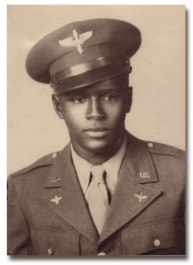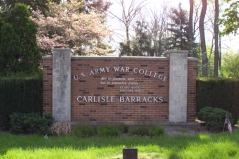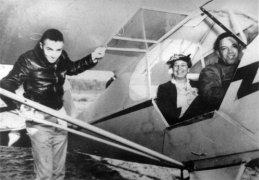American War Birds of Color; the Tuskegee Airmen
“Black History is OUR History.” ~ Cheri M. Roberts
The same year that Martin Luther King, Jr. graduated from Booker T. Washington High School and Malcolm X was ordered to register for the draft, another notable young African-American male’s draft number was called. It was 1943 and the United States was deeply ingrained in WWII as a young James Harvey entered the United States Army during what was one of the most ideologically and culturally tumultuous times in world history. The Nazis had already killed more than one million Jews and racism and segregation in America was at a boiling point.
“The disadvantage of men not knowing the past is that they do not know the present.” ~ G. K. Chesterson
By October of 1944 Harvey graduated from Aviation Cadet Training at the Tuskegee Army Air Field as a Second Lieutenant Flying Officer and entered “The Experiment”, a program whose test subjects became known as the Tuskegee Airmen. Only a small handful of these Airmen ever flew Red Tail fighter craft becoming the first black fighter pilots in WWII history. Flying over 1,500 missions this small group of legendary Tuskegee Airmen became widely known as the “Best Fighter Group” in the Army Air Corp and subsequently the United States Air Force and finally, on July 26, 1948 President Truman signed Executive Order 9981.
“It is hereby declared to be the policy of the President that there shall be equality of treatment and opportunity for all persons in the armed services without regard to race, color, religion, or national origin.” ~ 33rd President Harry Truman
Having endured the horrors of WWII and the fierce indignities of racial hatred and ignorance it was still more than six decades later – after legislative maneuvers by Sen. Carl Levin, D-Mich., and Rep. Charles Rangel, D-N.Y., and signed by then President George W. Bush, that Lt. Col. James H. Harvey and the other Tuskegee Airmen were finally recognized and awarded the Congressional Medal of Honor.
“We can deny our heritage and our history, but we cannot escape the responsibility for the results.” ~ Edward R. Murrow
Before the Tuskegee Airmen came to be, no “black” had been allowed to be a U.S. military pilot. In 1917, men of color tried to become aerial observers, but were rejected. African-American Eugene Bullard served as one of the pilots with the French Lafayette Escadrille Air Group, but was denied the opportunity to transfer to American military units as a pilot although the other American pilots in the unit were offered the chance. Instead, Bullard returned to infantry duty with the French.
A 1925 study conducted by the Army War College concluded that African-Americans were inherently ill-suited for combat both physically and psychologically. The study reported that African-Americans had smaller than average brains therefor making them unsuitable to pilot fighter or bomber aircraft. It wasn’t until April 3, 1939, that Public Law 18 was passed. The Law provided for an expansion of the Army Air Corps. One section of the law called for the creation of training programs to be located at black colleges. These programs were to prepare African-Americans for service in a variety of areas in the Air Corps support services.
The US government formed an all-black flying unit at the Tuskegee Institute in Tuskegee, Alabama where the Civilian Pilot Training Program (CVTP) fell under the direction of Charles A. Anderson, one of the nation’s first African-Americans to earn a pilot’s license. Bessie Coleman, a woman, was the very first African-American to earn a pilot’s license. After the Army chose nearby training grounds for the new segregated 99th Pursuit Squadron in January of 1942, the story of the Tuskegee Airmen really began.
“There are those who say to you – we are rushing this issue of civil rights. I say we are 172 years late.” ~ Speech at Democrat National Convention, 14th July 1948
In 1942 Eleanor Roosevelt visited Tuskegee Army Airfield where she took a flight that was piloted by instructor Charles A. Anderson. The flight lasted more than an hour and proved to the First Lady that blacks could indeed fly airplanes. She immediately became one of the biggest champions of these phenomenal pilots, taking home a photograph of her flight to show her husband, the President of the United States. She was able to successfully urge FDR to utilize the 99th Squadron in combat missions.
In March 1942, the Tuskegee Airmen’s 99th Fighter Squadron was activated with newly promoted Colonel Davis in command. No white commander wanted to accept these pilots. The unit was forced to wait a year for deployment. Finally the Airmen were attached to the 33rd Fighter Group, Tactical Air Force and sent to North Africa. Benjamin O. Davis Jr., commanded Red Tails, the 332nd Fighter Group and was the first African-American General in the U.S. Air Force, following in his father’s footsteps. Benjamin O. Davis, Sr. was the very first African-American General in the United States Army.
“A small body of determined spirits fired by an unquenchable faith in their mission can alter the course of history.” ~ Mahatma Gandhi
President Harry S. Truman‘s Executive Order 9981 in 1948 called for “equal opportunity” and was said to have officially ended racial inequality in the military however, never once did he mention integration. In actuality, desegregation was officially announced earlier in April 1948, by Gen. Carl Spaatz, the Air Force Chief of Staff, when he made a public announcement stating that, the “Air Force would desegregate to improve its combat effectiveness.”
By May of 1949, the Air Force published regulations dismantling segregation and by July of the same year, men joining the Air Force were assigned according to their ability, not their race for the first time in history. African-American airmen ascended in rank quickly. For the first time, white military members took orders from higher ranking black Officers without issue and with due respect. Many disillusions about blacks had been shattered.
The Air Force was the first service to fully integrate its ranks. For that we owe the Tuskegee Airmen.
“Courage is rightly esteemed the first of human qualities… because it is the quality which guarantees all others.” ~ Winston Churchill
Despite prevalent racial discrimination during one of our country’s darker moments, the Airmen’s story is full of human triumph. No other single group in America has struck a more significant blow against the forces of racism than the Tuskegee Airmen. They embody moral courage and that American “can-do” spirit. History loves a great underdog story and what is often neglected and seldom expressed is that it was their strength of character that made them arguably some of the best pilots in the Army Corp in WWll, and later in the newly formed United States Air Force.
At a time when America seeks role models worthy of our inspiration, one needs to look no further than the Tuskegee Airmen. Much more than a story of man and machine, their’s is a story that helped profoundly to define an entire race while embodying the sum of humanity’s greatest traits. Few today realize these men were the forefathers of the entire civil rights movement. Their contributions are what lit the runway for future civil rights leaders like Rosa Parks and Martin Luther King Jr. The Airmen’s sacrifice is what later allowed Sculptor Artist – Ed Dwight, the chance to become America’s first ever black astronaut candidate. And, it is their hard-earned legacy that decades later inspired 23 year-old Barrington Irving to break the world record in becoming the youngest and first African-American pilot to fly solo around the world.
“We, who are the living, possess the past. Tomorrow is for our martyrs.” ~ Lay Bare The Heart: An Autobiography of the Civil Rights Movement
It was the essential concepts and principles of leadership, courage, discipline, and commitment that allowed these African-American aviators to endure and overcome. They have left behind a true legacy that is a testimony to their focus and dignity in the face of outrageous discrimination brought on by ignorance and tradition. Their strength of character should inspire us all to become better people in the face of any adversity so that we all may share “Blue Skies”.
Related articles
- Tuskegee Airman downplays historic role (beaconnews.suntimes.com)
- Tuskegee Airmen watch Obama’s swearing-in (news.muckety.com)
- Red Tails a battle for respect (lfpress.com)
- In Their Own Words: The Tuskegee Airmen A Documentary by Bryton Entertainment, LLC. (literarycorrectness.com)
- Tuskegee Airmen Honored Guests at Inaugural (blackamericaweb.com)
- Tuskegee Airman visits Martin Luther King Jr. Leadership Academy (mlive.com)
- Service Honors One of Original Tuskegee Airmen (abcnews.go.com)
- Methuen Member Of Famed Tuskegee Airmen Passes Away (boston.cbslocal.com)








Reblogged this on The ObamaCrat.Com™ and commented:
Great post Ms. Cheri. Too great not to share & reblog. Thank you very much.
LikeLike
This is amazing, Cheri. I’ve never heard of the Tuskegee Airmen before. What an inspiring story!
LikeLike
Thank Di. Please share?
Feb. is Black History month here in the States. The Tuskegees were swept under the rug for a very very long time. Sadly most have passed away. Lt. Col. Harvey is a personal friend of mine. I also do a little PR work for him from time to time. He is now 89 years old and one of only two remaining original Tuskegee “Top Guns” …not all Tuskegee Airmen were actually fighter pilots. They truly and literally do not have much time left to enjoy our admiration and thanks.
LikeLike
Pingback: The Idea Factory « Cheri Speak
Pingback: Corporate Media Ramps Up Pro-Vaccine Rhetoric | Challenging the Rhetoric